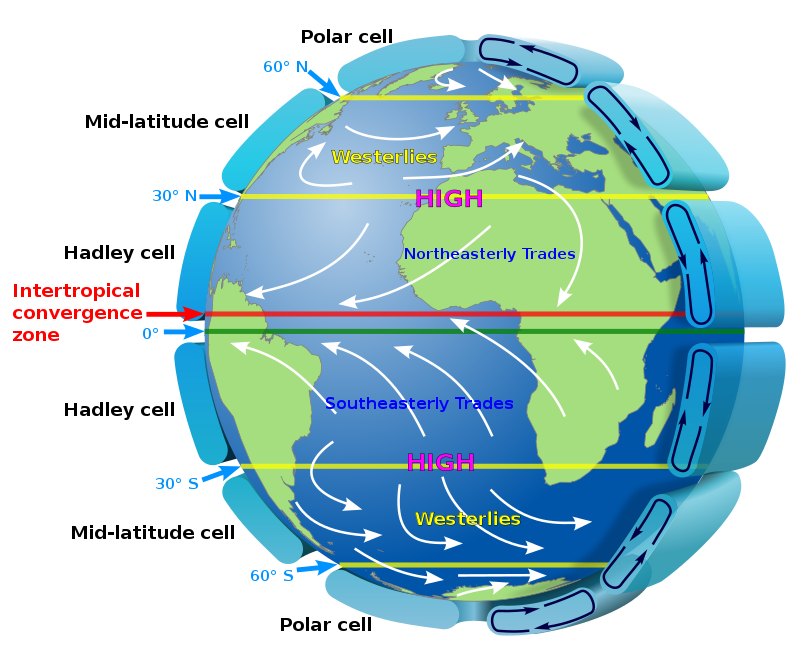The wind belts circling the planet are organised into three cells in each hemisphere—the Hadley cell, the Ferrel (mid-latitude) cell, and the polar cell. These cells exist in both the northern and southern hemispheres. The vast bulk of the atmospheric motion occurs in the Hadley cell. Within the Hadley cells, the trade winds blow towards the equator, then ascend near the equator as a broken line of thunderstorms, which forms the Inter-Tropical-Convergence Zone (ITCZ). From the tops of these storms, the air flows towards higher latitudes, where it sinks to produce high-pressure regions over the subtropical oceans and the world's hot deserts, such as the Sahara desert in North Africa
In the middle cells, which are known as the Ferrel (mid-latitude) cells, air converges at low altitudes to ascend along the boundaries between cool polar air and the warm subtropical air that generally occurs between 60 and 70 degrees north and south. This often occurs around the latitude of the UK, which gives us our unsettled weather.
[Source: Wikipedia, The Met Office national meteorological service, UK]

[Source: Kaidor, Wikipedia, based on NASA / Public domain]
[Source: The Met Office national meteorological service, UK]
The polar front jet occurs over mid latitudes between the Ferrel and Polar cells, and strongly influences the weather over the UK and Europe. Mid-latitude low pressure systems occur on the polar, or northern side of the jet stream, while more settled, warmer conditions are found to the south. A stationary jet stream pattern will bring frequent low pressure systems to the same region.
[Source: The Met Office national meteorological service, UK]
The Met Office, UK have further videos and explanations here:
Met Office - Global Circulation PatternsThe rotation of the Earth on its axis deflects the atmosphere toward the right in the Northern Hemisphere and toward the left in the Southern Hemisphere, resulting in curved paths. The deflection of the atmosphere sets up the complex global wind patterns which drive surface ocean currents. This deflection is called the Coriolis effect.
[Source: NOAA, National Oceanic and Atmospheric Administration]
[Source: Atlas Pro, YouTube]
View the current UK, Europe - Long Range Weather Forecast; 16-day forecast.
All major web browsers support the Ctrl+D shortcut key combination to quickly access the bookmarks creation menu.
Web page constructed in Newcastle upon Tyne, UK, by Robin Broad , Starbird Digital, June 2020.
This web page meets World Wide Web HTML and CSS standards.
Built and tested in a GNU/Linux environment in Newcastle upon Tyne, England.
Hosted in Provo, Utah, USA.

